“At the time in which I was filling out the list of TOKO products that I wanted to bring to for Canada, for Lake Louise races, I did not know yet of the craving for the new TOKO top finish. Hence, I put on my list an amount of them.. I would say “normal”, adding then some pieces of the products of the past seasons.
Then, after being assaulted in Sölden for first race of the season, where TOKO top finish were totally sold out, I had to call my wife not once but two times in order to send me all I had at home…I literally emptied my personal storehouse.
At this point, I thought my list for Canada haven’t been satisfactory.
During the first Canadian week I distributed carefully TOKO top finish for Men World Cup training and races, and I finally realized they would haven’t been enough for Ladies World Cup races of the next week. As soon as ladies skimen arrived in Lake Louise, they started asking me about the new top finish and in only one day I run out of all my stock. As if we were attending to a wedding buffet with the most delicious food ever, the firsts arrived took as many products as they can in order to be sure to have enough material (sprays) for skis preparation. I would say anybody can’t be comfortable without the new TOKO top finish ;)”
TOKO Cross Country WC Race Service – Christian Schocher
Roger Wachs, Switzerland Cross Country National Team Technician: Toko products can be compared with a Swiss watch. You can always rely on them. The products stand for high quality and continuity. New products don’t need to be tested. It’s guaranteed that they are performing.
Urban Nilsson, Sweden Cross Country National Team Technician: Toko products are top rated in every test. The products are performing in all conditions and they are always a guarantee for fast skis.
Yves Bilodeau, Cross Country Canada Team Technician, “We love this sh#%. It is always #$%@ing fast!”
TOKO Biathlon WC Race Service – Torsten Thrän
Extraordinary good sales figures in November, December and at the first worldcup events in January
Presuming that one can holds for 6-8 pairs of skis, 3500-4700 competition and test skis have been waxed with TOKO HelX in this period
Reorder of one team in January…
110 liquids and powders (30 HelX 2.0 yellow, 20 HelX 2.0 red, 30 Jetstream 2.0 red and 30 HB 004)
These figures speak for themselves.
Statements…
“HelX 2.0 products have a significantly longer top performance compared to other liquids” (Team GER)
“For Top Finish we use 90 % Toko products” (Team CZ)
“The new top finish line is significantly better than the old line with the same big range of application” (Team France)
“The new top finish line is a big step ahead” (Team Sweden)
“Very fast and easy application of the new HelX. This also helps if a fast reaction is needed due to short-term weather changes”. (Team GER)
“I’ve never seen a complete new top finish line made such an impact…” (Team CZ)
“We fully trust in Toko products based on the experience we made when they first launched HB004 at the Biathlon World Champs in NoveMesto 2013.” (Team FIN)
“Very nice spray pattern with the new HelX” (Team BLR and Team Slovakia)
“Make sure to bring enough material to Sochi!” (various teams)
“I need 3 HelX yellow. You only have 5 left. Ok. In this case I’ll take all of them”. (Team NOR at WC Oberhof)
“We now need the top finish line also for the IBU Cup team” (Team Poland, Team SWE, Team CZ and Team GER
“Your Udo is a wizard” (Team SWE)
Application of HelX 2.0
Application is different from the old HelX!
Spray on HelX evenly throughout the base. Let it dry for a few minutes. Ready to go!!
Avoid corking and polishing: the finish is as good as it will get. An “unfinished” HelX 2.0 application is smoother and “more finished” than a polished old HelX application.This is because the HelX 2.0 is extremely fine (small particles) making it both faster and more durable (gets “into” the base more and is more difficult to “knock off”). Because HelX 2.0 is far more durable, it is now viable for all Nordic races – far more than the last version.
Liquid topcoats such as HelX 2.0 are generally a disadvantage in dirty snow
 |
| Alpine: Topfinish HelX 2.0 |
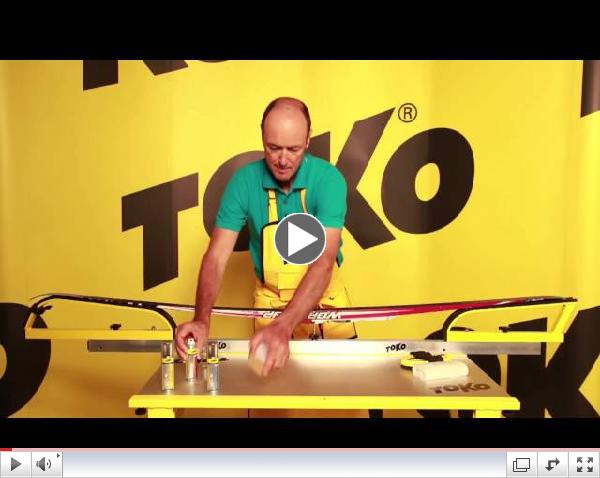 |
| Nordic: Topfinish HelX 2.0 |
Application of JetStream 2.0
There are many ways to apply JetStream 2.0 much like any other bloc or powder product.
The application is similar to the previous JetStream products except that if ironing, the iron temp needs to be hotter (160c+).
Alpine/Snowboard Application:
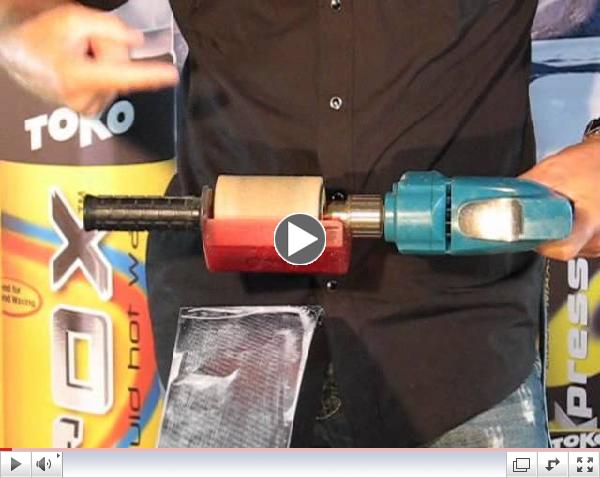 |
| JetStream Application Rotocork (Alpine/Snowboard) |
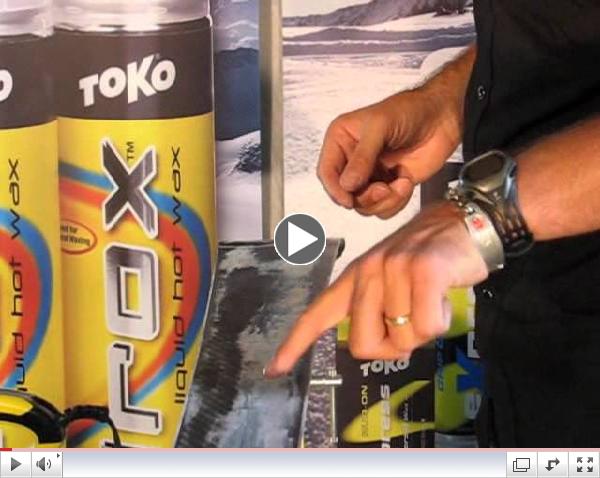 |
| JetStream Application Iron (Alpine/Snowboard) |
With the JetStream 2.0 waxes, the iron needs to be hotter (320f+/160c+)
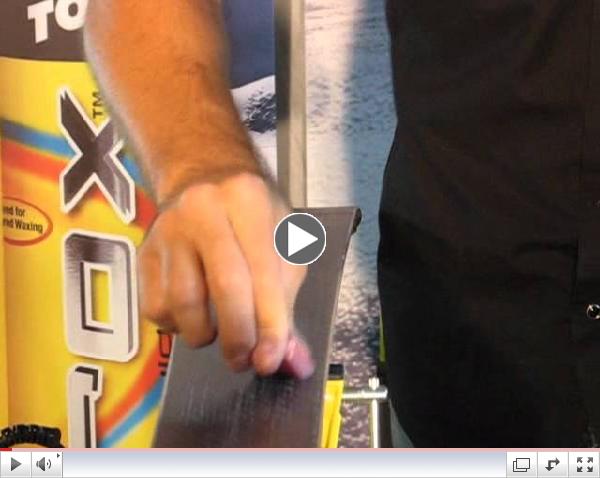 |
| JetStream Application Cold (Alpine/Snowboard) |
Nordic Application:
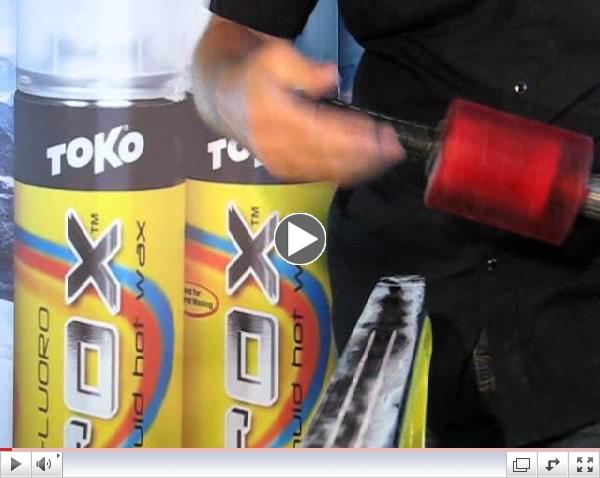 |
| Ironing JetStream (Cross Country) |
With the JetStream 2.0 waxes, the iron needs to be hotter (320f+/160c+)
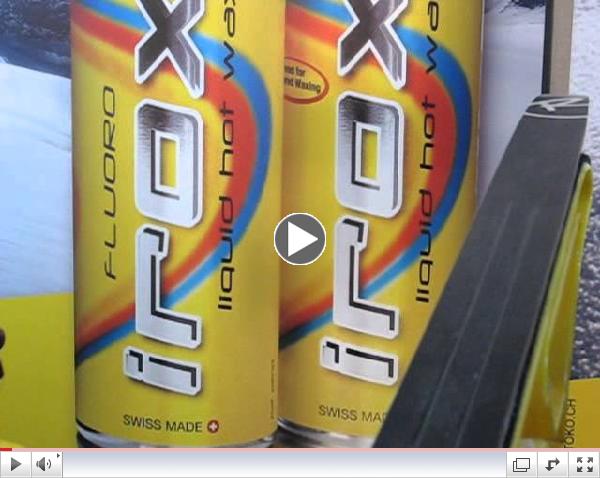 |
| Rotocorking JetStream (Cross Country) |
All of the above videos and many more can be found at TokoVideos.com.
NEW EFFECTIVE APPLICATION METHOD FOR NORDIC – BEST ALL AROUND IN OUR OPINION:
This technique was tested for use in dry powder snow, wet new snow, and both clean and dirty corn snow. Testing included multiple testers using a blind testing method over many testing days including dramatically different conditions (all of the main conditions covered) with double blind skis (there were doubles of the same wax and preparation methods so as to expose inconsistencies).
We tested it for durability and dirt resistance as well as without skiing it in and it was as good or better as all other methods in any condition which is noteworthy because some methods are better in some kinds of snow than others.
We are comfortable recommending this method for all Nordic ski racers from weekend warriors to the highest level.
JetStream 2.0 Iron-on with Fiberlene Application Method
We are assuming that the skis have had the appropriate HF wax applied, scraped, and brushed out well.
Set iron to 320f (160c). This is full blast on the T14 Digital Iron. If you have an iron that goes hotter, you can go as hot as 190c.
Rub as much JetStream bloc as you can on the base.
Take a strip of fiberlene and hold it under the base of the iron such that when the iron comes onto the ski, the fiberlene will be between the ski base and iron base thus insulating the ski base and preventing “sticky spots”.
Iron the ski from tip to tail in a slow pass (20-30 seconds)
Inspect the base. The base should look mostly black with small white areas. If most of the base is white, take another pass concentrating on the white areas. If the base has become very hot, let it cool before taking the second pass.
Brush out with Nylon Polishing Brush. Polish with Thermo Pad.

